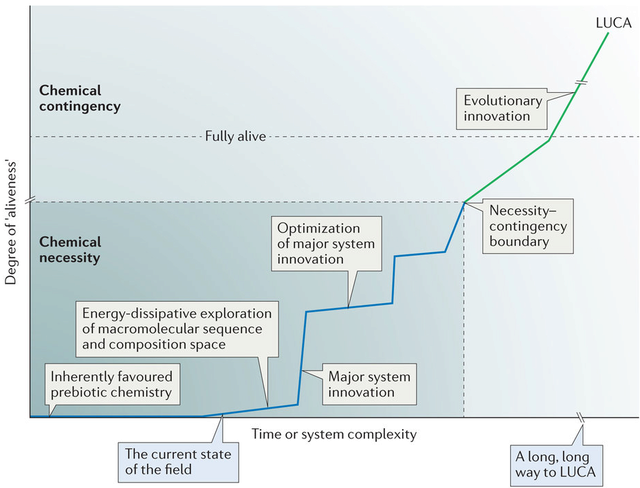Mineral evolution
It is believed that biological processes started to affect Earth’s surface mineralogy by 3.85–3.6 Ga


First of all there was the origin of life (OOL) events that produced the first living organism. Then there was a tremendous amount of evolutionary progress leading to the last universal common ancestor (LUCA) of today’s extant species. LUCA probably had DNA, an impermeable phospholipid membrane with much the same small army of proteins that attend to today’s cell membranes, the famed ATPase turbine-driven enzyme for ATP construction, protein synthesis machinery like today’s cells, the universal DNA code and DNA repair mechanisms. In short, LUCA was, as Goldman explains, a “sophisticated cellular organism that, if alive today, would probably be difficult to distinguish from other extant bacteria or archaea.”
Strangely enough DNA replication that we see in today’s cells was not present in LUCA. Instead RNA polymerases performed that job. Later in evolutionary history, today’s complex and circuitous DNA replication incredibly evolved independently several times. Also the aminoacyl tRNA synthetases underwent considerable horizontal gene transfer (HGT).
This is but a small sampling of the complicated evolutionary narrative of early life. And what exactly is the evidence for this Darwinian choreography leading from OOL to LUCA and finally to the three cell domains? Well actually there is, err, none.
In fact, not only is there no evidence for this narrative, evolutionists have repeatedly been stymied in their attempts to demonstrate how it would work in the laboratory. In fact, they can’t even demonstrate how it would work outside of the laboratory. Even when evolutionists are free to speculate and hypothesize with computer models or cartoon renditions, the problem still resists solution because it is too unlikely.
And so why do evolutionists believe all these things about early evolution? Because this circuitous narrative is required if evolution is true. In other words, the evidence for all these things is the fact of evolution. If the species spontaneously arose, as evolutionists insist is a fact, then this early life narrative, in one form or another must have occurred.
They are forced to believe that the OOL somehow occurred, in spite of the science. They are forced to believe that incredible complexity evolved early in evolutionary history because today’s extant species have too much in common. From an evolutionary perspective, those similarities must have been present in LUCA. Likewise DNA replication must not have been present in LUCA because the DNA replication machinery in today’s species reveals too many differences.
Furthermore the aminoacyl tRNA synthetases fail to form an evolutionary tree. So evolutionists must believe HGT caused the confusion. There is no independent evidence that HGT changed around the aminoacyl tRNA synthetases. The evidence simply is the failure to find an adequate evolutionary tree to explain these enzymes.
Similarly there is no evidence that today’s complex and circuitous DNA replication evolved independently several times. Again it is a result of believing in evolution. If the species spontaneously arose then, yes, DNA replication must have evolved independently several times.
Early evolution is an example of how evolution violates Occam’s Razor. Science seeks parsimonious solutions, but evolution leads to circuitous narratives. Religion drives science, and it matters.
1) http://darwins-god.blogspot.com.br/2014/03/guess-evidence-for-early-evolution.html
Last edited by Admin on Sun Feb 19, 2017 5:07 pm; edited 6 times in total






